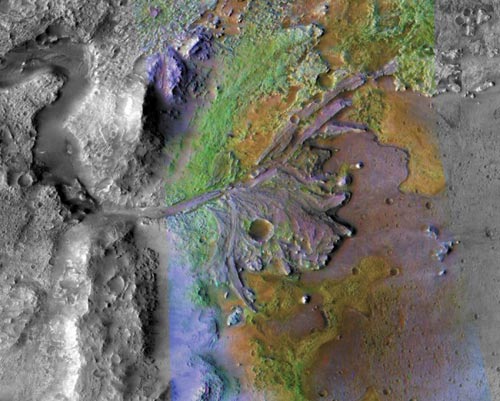Found evidence of water covering the whole of Mars
Photographs from NASA's MRO satellite show that there was water on Mars's surface, even a lot of water. This raises the hope that the 'red planet' may have life.
Researchers have found evidence of large lakes, rivers and deltas, formed on Mars in the early days. All of them are potential habitats for bacterial proliferation.
They also discovered that humid conditions in this place probably existed for a long time on the 'red planet'.
This information was published in Nature and Nature Geoscience.
One study found that many ancient highlands (accounting for half of the total area of Mars) contain clay minerals, which can only form in conditions of water. Volcanic lava has buried these rich clay regions in the next period, the more dry period in the history of Mars formation. However, the volcanic impact later revealed thousands of clay areas throughout Mars.
This data was discovered by the Mars spectroscopy system called CRISM on the MRO satellite (Mars Reconnaissance Orbiter) discovered by NASA. CRISM's operating principle is 'reading' over 500 colors because sunlight reflects to detect specific minerals on the surface of Mars.

Rivers carry clay minerals that flow into the Jezero crater on Mars.(Photo: AP)
Scott Murchie, a scientist from John Hopskins University in Maryland, USA, commented: 'The biggest surprise from these results is that the water has spread and survived on Mars as well as the wet environment. different here. '
The mineral, known as the stone phyllosilicates, holds information about the interplay between water and rock from the Noachian period in the history of Mars formation - lasting from about 4.6 billion to 3.8 billion. last year. Much of the rock on Earth during this period was destroyed by the process of geological tectonics. They still exist on the Moon but never turn into liquid water.
Therefore, rock phyllosilicates on Mars store unique information about the water environment during the early solar system, and some of them can be stable long enough for life to proliferate.
More importantly, CRISM has discovered hydrate-containing silicates in their crystalline structures - in sediments deposited by water. These clay minerals are found in the deltas within Holden, Eberswalde and Jezero craters on Mars.
September 2009 NASA will send an explorer robot named MSL (Mars Science Laboratory) to Mars in search of signs of the present and past life of this "dead planet" .
European Space Agency ESA also plans to launch its research vessel, ExoMars, on Mars in 2013.
- Evidence of water once flowing on Mars
- NASA: New evidence of water on Mars
- Find evidence of groundwater around Mars?
- Add evidence of water on Mars
- Discovering vestiges of streams on Mars
- More evidence of water on Mars
- Detects significant amount of water in the soil on Mars
- Detecting signs of water flowing on Mars
- Water freezes right under the surface of Mars
- Detecting snow on Mars
- The ice sheet on Mars can provide water for future residents
- More evidence of life on Mars
 Van Allen's belt and evidence that the Apollo 11 mission to the Moon was myth
Van Allen's belt and evidence that the Apollo 11 mission to the Moon was myth The levels of civilization in the universe (Kardashev scale)
The levels of civilization in the universe (Kardashev scale) Today Mars, the sun and the Earth are aligned
Today Mars, the sun and the Earth are aligned The Amazon owner announced a secret plan to build a space base for thousands of people
The Amazon owner announced a secret plan to build a space base for thousands of people